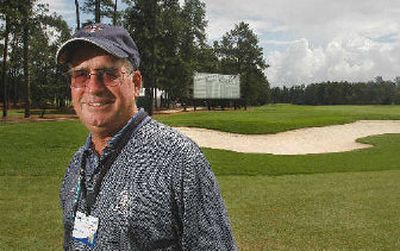Love-hate relationship

A famous mantra for the U.S. Open is that it seeks to identify the best players, not embarrass them. At times, Tom Meeks has been known to infuriate them.
Tom Lehman berated him for the silly pin placement on the 18th hole at Olympic Club. Nick Price challenged him for making the fairway nearly impossible to reach on the 492-yard 10th hole at Bethpage Black. A long list of players ridiculed him for the seventh green at Shinnecock Hills last year.
As the person in charge of setting up the golf course for the U.S. Open the past 10 years, Meeks should have expected his share of confrontations. But there was one exchange with the late Payne Stewart that made his job worth all the grief.
Meeks had a two-year battle with Stewart, starting in 1998 at Olympic Club when Stewart three-putted for bogey from 8 feet because of a hole location that resembled miniature golf. Plus, it was Meeks who put him on the clock for slow play in the final round, right after Stewart hit a perfect tee shot into a sand-filled divot.
Stewart lost by one shot at Olympic, and it didn’t take him long to run into Meeks at Pinehurst No. 2 the following year. He complained about the 489-yard 16th hole, which had been converted into a par 4.
“He said, ‘That green was not designed for a long shot, it was designed for a short shot,’ ” Meeks recalled. “I said, ‘Tell you what, Payne, we’ll move the tee back and make it 530 yards if you promise you and everyone else won’t go for the green in two.’ He just looked at me and said, ‘You’re impossible!’ “
The 16th hole is where Stewart began his rally in the final round, and he won the 1999 U.S. Open with a 15-foot par putt on the final hole. Meeks bumped into Stewart when it was over, and heard something that reduced him to tears.
“He grabbed me downstairs and took me into the locker room tunnel and we embraced,” Meeks said. “He said, ‘Tom, you set up one hell of a golf course.’ That was the biggest compliment I ever had. That comment will go down as one of my career highlights at the USGA.”
Compliments don’t come easily for the senior director of rules and competition, who is setting up the course for his final U.S. Open at Pinehurst No. 2 and will retire later this summer after 30 years with the USGA.
Some believe sports officials are doing a great job when no one knows who they are. The fact that Meeks has become such a central figure in the U.S. Open speaks more to the job he is assigned to do than the job he has done.
The U.S. Open is known as the toughest test in golf. Meeks’ job is to make sure it’s just that.
“In a perfect world, it would be nice if all the players would give me a hug and say, ‘Good job.’ But they’re not going to do that,” Meeks said. “If you don’t hear something, that’s good. I usually hear on Monday, Tuesday and Wednesday that it’s the best setup ever. Come Thursday, when you put a pencil in their hands, that’s when it changes.”
Mention the name “Tom Meeks” and the reaction is almost universal – a sinister smile, a long pause and a polite answer.
“I think he’s … um … what’s a good word? Very testing,” Davis Love III said. “He wants you to be tested. The only problem the USGA has is that they think we’re better than we are.”
Ernie Els danced around the question. He was furious last year when, after making double bogey on the first hole on his way to an 80 in the final round, he learned that Meeks had told the Boston Globe, “I think Ernie Els gave up after the first hole.”
Meeks later apologized.
Justin Leonard gave the definitive analogy of Meeks.
“He’s kind of like that professor in that really hard accounting class,” Leonard said. “You knew that you had to go through this class and this professor in order to graduate, and like 70 percent of the people got out of the business school because of that professor. Yet if you made it through him, you were better off for it.”
If Stewart’s embrace at Pinehurst was the highlight of his career, the lowlight came at Olympic Club in San Francisco, when Meeks decided to put the hole location on the 18th green in the back left during the second round, knowing it might be a gamble because of the slope.
It turned into a fiasco.
Any putt that missed the cup wound up rolling toward the bottom of the hill. Lehman four-putted for double bogey and stormed off the course. Stewart was in the lead and facing an 8-foot birdie. He narrowly missed, and watched the ball roll 25 feet away.
“I felt horrible about that,” he said, calling it his worst mistake in 10 years setting up U.S. Opens.
As stern a test as he provides, Meeks has managed to maintain a congenial relationship with players because of his amiable personality.
Lehman bristled when asked to name Meeks’ biggest gaffes.
“You’re choosing to remember somebody for just a couple of mistakes,” Lehman said. He conceded that the 18th at Olympic Club was a big mistake, but added, “I would simply ask people to think of all the great things he’s done.”